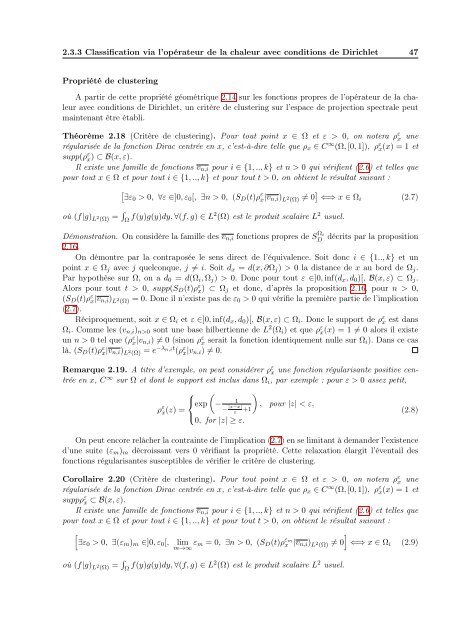Contributions à l'étude de la classification spectrale et applications
Contributions à l'étude de la classification spectrale et applications
Contributions à l'étude de la classification spectrale et applications
Create successful ePaper yourself
Turn your PDF publications into a flip-book with our unique Google optimized e-Paper software.
2.3.3 C<strong>la</strong>ssification via l’opérateur <strong>de</strong> <strong>la</strong> chaleur avec conditions <strong>de</strong> Dirichl<strong>et</strong> 47<br />
Propriété <strong>de</strong> clustering<br />
A partir <strong>de</strong> c<strong>et</strong>te propriété géométrique 2.14 sur les fonctions propres <strong>de</strong> l’opérateur <strong>de</strong> <strong>la</strong> chaleur<br />
avec conditions <strong>de</strong> Dirichl<strong>et</strong>, un critère <strong>de</strong> clustering sur l’espace <strong>de</strong> projection <strong>spectrale</strong> peut<br />
maintenant être établi.<br />
Théorème 2.18 (Critère <strong>de</strong> clustering). Pour tout point x ∈ Ω <strong>et</strong> ε > 0, on notera ρ ε x une<br />
régu<strong>la</strong>risée <strong>de</strong> <strong>la</strong> fonction Dirac centrée en x, c’est-<strong>à</strong>-dire telle que ρx ∈ C ∞ (Ω, [0, 1]), ρ ε x(x) = 1 <strong>et</strong><br />
supp(ρ ε x) ⊂ B(x, ε).<br />
Il existe une famille <strong>de</strong> fonctions vn,i pour i ∈ {1, .., k} <strong>et</strong> n > 0 qui vérifient (2.6) <strong>et</strong> telles que<br />
pour tout x ∈ Ω <strong>et</strong> pour tout i ∈ {1, .., k} <strong>et</strong> pour tout t > 0, on obtient le résultat suivant :<br />
où (f|g) L 2 (Ω) = <br />
∃ε0 > 0, ∀ε ∈]0, ε0[, ∃n > 0, (SD(t)ρ ε x|vn,i) L 2 (Ω) = 0 ⇐⇒ x ∈ Ωi<br />
Ω f(y)g(y)dy, ∀(f, g) ∈ L2 (Ω) est le produit sca<strong>la</strong>ire L 2 usuel.<br />
Démonstration. On considère <strong>la</strong> famille <strong>de</strong>s vn,i fonctions propres <strong>de</strong> S Ωi décrits par <strong>la</strong> proposition<br />
D<br />
2.16.<br />
On démontre par <strong>la</strong> contraposée le sens direct <strong>de</strong> l’équivalence. Soit donc i ∈ {1.., k} <strong>et</strong> un<br />
point x ∈ Ωj avec j quelconque, j = i. Soit dx = d(x, ∂Ωj) > 0 <strong>la</strong> distance <strong>de</strong> x au bord <strong>de</strong> Ωj.<br />
Par hypothèse sur Ω, on a d0 = d(Ωi, Ωj) > 0. Donc pour tout ε ∈]0, inf(dx, d0)[, B(x, ε) ⊂ Ωj.<br />
Alors pour tout t > 0, supp(SD(t)ρε x) ⊂ Ωj <strong>et</strong> donc, d’après <strong>la</strong> proposition 2.16, pour n > 0,<br />
(SD(t)ρε x|vn,i) L2 (Ω) = 0. Donc il n’existe pas <strong>de</strong> ε0 > 0 qui vérifie <strong>la</strong> première partie <strong>de</strong> l’implication<br />
(2.7).<br />
Réciproquement, soit x ∈ Ωi <strong>et</strong> ε ∈]0, inf(dx, d0)[, B(x, ε) ⊂ Ωi. Donc le support <strong>de</strong> ρε x est dans<br />
Ωi. Comme les (vn,i)n>0 sont une base hilbertienne <strong>de</strong> L2 (Ωi) <strong>et</strong> que ρε x(x) = 1 = 0 alors il existe<br />
un n > 0 tel que (ρε x|vn,i) = 0 (sinon ρε x serait <strong>la</strong> fonction i<strong>de</strong>ntiquement nulle sur Ωi). Dans ce cas<br />
l<strong>à</strong>, (SD(t)ρε x|vn,i) L2 (Ω) = e−λn,it (ρε x|vn,i) = 0.<br />
Remarque 2.19. A titre d’exemple, on peut considérer ρ ε x une fonction régu<strong>la</strong>risante positive centrée<br />
en x, C ∞ sur Ω <strong>et</strong> dont le support est inclus dans Ωi, par exemple : pour ε > 0 assez p<strong>et</strong>it,<br />
ρ ε ⎧ <br />
⎨<br />
1<br />
exp −<br />
x(z) =<br />
⎩<br />
0, for |z| ≥ ε.<br />
− |z−x|<br />
ε +1<br />
<br />
, pour |z| < ε,<br />
On peut encore relâcher <strong>la</strong> contrainte <strong>de</strong> l’implication (2.7) en se limitant <strong>à</strong> <strong>de</strong>man<strong>de</strong>r l’existence<br />
d’une suite (εm)m décroissant vers 0 vérifiant <strong>la</strong> propriété. C<strong>et</strong>te re<strong>la</strong>xation é<strong>la</strong>rgit l’éventail <strong>de</strong>s<br />
fonctions régu<strong>la</strong>risantes susceptibles <strong>de</strong> vérifier le critère <strong>de</strong> clustering.<br />
Corol<strong>la</strong>ire 2.20 (Critère <strong>de</strong> clustering). Pour tout point x ∈ Ω <strong>et</strong> ε > 0, on notera ρ ε x une<br />
régu<strong>la</strong>risée <strong>de</strong> <strong>la</strong> fonction Dirac centrée en x, c’est-<strong>à</strong>-dire telle que ρx ∈ C ∞ (Ω, [0, 1]), ρ ε x(x) = 1 <strong>et</strong><br />
suppρ ε x ⊂ B(x, ε).<br />
Il existe une famille <strong>de</strong> fonctions vn,i pour i ∈ {1, .., k} <strong>et</strong> n > 0 qui vérifient (2.6) <strong>et</strong> telles que<br />
pour tout x ∈ Ω <strong>et</strong> pour tout i ∈ {1, .., k} <strong>et</strong> pour tout t > 0, on obtient le résultat suivant :<br />
<br />
∃ε0 > 0, ∃(εm)m ∈]0, ε0[, lim<br />
m→∞ εm = 0, ∃n > 0, (SD(t)ρ εm<br />
<br />
x |vn,i) L2 (Ω) = 0 ⇐⇒ x ∈ Ωi (2.9)<br />
où (f|g) L 2 (Ω) = <br />
Ω f(y)g(y)dy, ∀(f, g) ∈ L2 (Ω) est le produit sca<strong>la</strong>ire L 2 usuel.<br />
(2.7)<br />
(2.8)

















